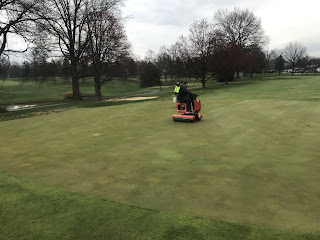 |
| Tulips in bloom |
The spring annuals are in full swing at WHCC. The daffodils are in full bloom, the tulips are putting on flowers, and the pots and window boxes are filled with pansies, tulips, and hyacinths. Many flowering trees and shrubs are in full spring color, such as, magnolias, redbuds, pears, serviceberries, and viburnums. As the temperature warms many other plants will put on blooms and it is looking like the tulips will be in full bloom for Easter Sunday.
 |
| Daffodils in full bloom |
 |
| Pansies, hyacinths (good fragrance), and tulips in pots |
 |
| Appalachian Red Redbud behind #9 green |
 |
| Lavender Twist Redbud |
 |
Tulips starting to bloom
|
 |
| Saucer Magnolia in bloom |
 |
| Star Magnolia in bloom |
 |
| White daffodils |
Many of you may have noticed the new landscape bed we put in behind #11 green. The plants included in this design are an autumn brilliance serviceberry tree, mini mauvette hydrangeas, Blazing star kobold, coreopsis 'zagreb', and karl foerster feather reed grass. The serviceberry is currently in full bloom, but all the other shrubs and perennials are just coming out of winter dormancy. They should fill in nicely in the upcoming months.
 |
| New landscape bed #11 green |
On the turf side, much of the cool season grass is exploding out of its winter dormancy. However as the grass grows so does the springtime weeds. Some of these weeds include dandelions,
purple deadnettle, chickweed and violet. One of the most invasive spring weeds is
lesser celandine. It is a short lived perennial that is on the rise in our area. It is a non native plant brought here from Europe in the 1800s. It blooms in the spring, then dies down to the ground in the summer and returns the following spring as an expanded colony. It forms a dense mat that chokes out many of our native woodland plants. We are currently making herbicide applications to eliminate this weed and the other springtime weeds that invade the golf course.
 |
| Lesser celandine in the woods by 4 tee |
 |
| Dandelions |
Another one of our "favorite" turfgrass weeds is putting on seed heads and is easy to spot this time of year.
Poa annua (annual bluegrass) is spread all throughout the golf course and is much more difficult to control then the other broadleaf weeds. It is a winter annual that puts out seed in the spring, dies in the heat of the summer, and germinates again in the cooler temperatures of autumn.
It differs from kentucky bluegrass by its lighter green color and has a light color ligule. We do use some chemicals to suppress its growth but it is very difficult to fully eradicate. I am sure I will have more to say about this plant during the summer months.
 |
| Poa annua seed heads |
 |
Poa annua and Kentucky bluegrass seed heads mixed together
|
Some areas of the course were torn up because of wear and tear or because of the late season ice storm with the subsequent cleanup work. Over the last couple of weeks a repair crew has laid down new fescue sod in many of these areas and in some of the stump hole areas.
 |
Fescue sod added around #18 bunker face
|
The irrigation system is now up and running. To accomplish this we had to turn on the main valve, pressurize the pumps and the system to get up to 100 psi, and bleed out the excess air by turning on each irrigation head. A couple of heads had to be replaced because of bad seals and water pressure damage but now the system is ready to go, once it stops raining.
 |
| Spring startup of the irrigation system |
Finally, I wanted to write a little about our greens maintenance program that is under way. We have verticutted the greens. This consists of slicing grooves into the green with a triplex riding mower with a slicing blade attachment. This stimulates turf growth, tightens up the turf, improves smoothness, and opens up the turf's root zone which alleviates some compaction allowing for more nutrient uptake. (for more about verticutting
click here) We, also, will be topdressing in the next couple of weeks. This will help smooth out the green, increase green speed, and decrease disease presence. Fertilization is also imperative for maintaining a healthy green and we will be beginning that process soon with liquid and granular applications.
This year we will be rolling the greens more often to increase green speed. We have two rollers. A light weight triplex roller and a heavier salco roller. The light weight roller is faster and less impact-full on the turf. It increases the green speed by about a foot. The heavier salsco roller takes more time to use but increases the green speed by about 1.25 feet, and it makes the green faster for a longer period of time. Both of these rollers will be used often during the golf season to maintain a consistent green speed.
 |
| Green after veticutting |
 |
| Light weight roller |
 |
Salsco roller
|
Brad Piecuch
Assistant Superintendent/Horticulturist





















